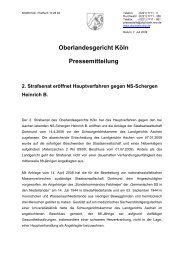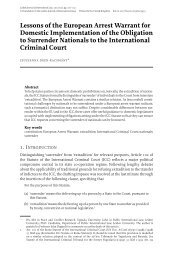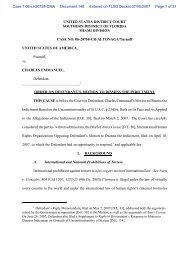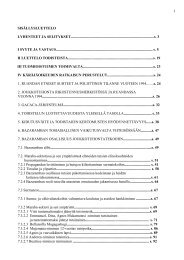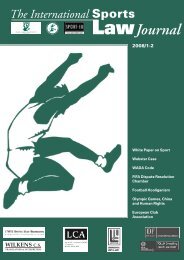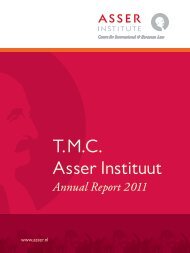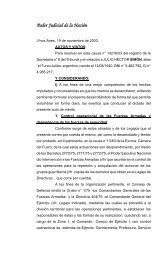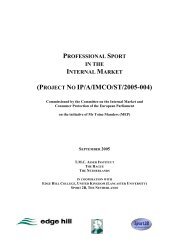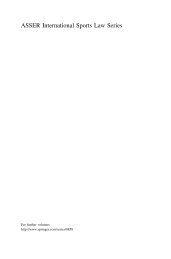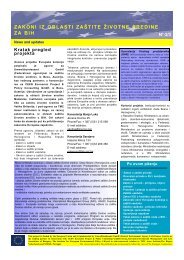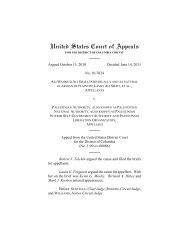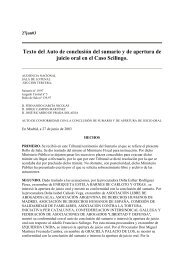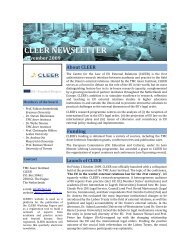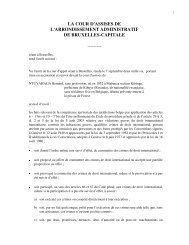Islj 2009 3-4 - TMC Asser Instituut
Islj 2009 3-4 - TMC Asser Instituut
Islj 2009 3-4 - TMC Asser Instituut
Create successful ePaper yourself
Turn your PDF publications into a flip-book with our unique Google optimized e-Paper software.
chance that clubs are contracting free agents for a higher salary than<br />
the marginal product of labor is bigger. It will lead to higher commissions<br />
to the sports agents and it will lead to even more entrants, who<br />
are willing to join the market.<br />
The literature makes clear that the sports agents are needed in the<br />
market of professional sports. The sports agents have some important<br />
functions, which solve market failures. Moral hazard and adverse<br />
selection will create market failures in the market of sports agents, but<br />
this can be solved by the license. Furthermore, the supply of sports<br />
agents will be enough. The high commissions, sports agents receive,<br />
will attract a lot of entrants in the market.<br />
The overview of the academic literature makes clear that there used<br />
to be a two-way relationship between the club and the player.<br />
Nowadays, this relationship evolved towards a three-way relationship,<br />
because the sports agents are included in the relationship. The clubs<br />
and players are accepting the role of the sports agents in the bargaining<br />
process.<br />
In the beginning of chapter 3, there is an overview of the different<br />
literature available in this field of research. The literature is explained<br />
by three topics: labor market of professional sports, business of sports<br />
agents and regulations of sports agents. It gives some interesting findings<br />
and it gives a good starting point for the empiric research. An<br />
example is that the athletes needed protection against the clubs,<br />
because they were the weaker participant in the negotiations. By the<br />
introduction of sports agents the protection was created, but nowadays<br />
the athletes also need protection against the sports agents.<br />
(Wilde, 1992)<br />
When the academic literature has been discussed, I gave an overview<br />
of the regulations applicable to the sports agents in the Netherlands. It<br />
has been divided in Europe regulation and Dutch regulation, in this<br />
overview every regulation on the sports agent is included. There was an<br />
interesting difference in two laws applicable to the sports agent. In the<br />
WAADI, the club was obliged to pay to the sports agent. In players’<br />
agents regulations of the FIFA, there was obliged that the player has to<br />
pay to the sports agent. So, it is hard for sports agents in Netherlands<br />
to obey every rule, because they are contra dictionary with each other.<br />
The results are given in chapter 4. In this chapter, a summary of all<br />
the interviews are given. At the beginning, I have set 6 hypotheses.<br />
These hypotheses were used during the interviews with the different<br />
actors. They could give their view and opinion about the subject. The<br />
clubs, sports agents and the unions were interviewed. They all serve different<br />
interests, which lead to contra dictionary statements. There are<br />
some interesting things pointed out, but everyone is clear about one<br />
thing. The sports agents need to be regulated, in order to keep the worse<br />
sports agents out of the market. If this is not the case, a lot of new<br />
entrants will go onto the market. They do not have the right incentives<br />
and do not want to serve the interest of the player. The bad quality<br />
sports agents are only looking to their own profits. The sports agent has<br />
an important role, according to the theory, but also according the different<br />
actors in the market. They are in place to protect the player from<br />
the power of the clubs. The sports agent needs to do function one until<br />
five, which are explained in chapter 2.1. At the end of the interviews I<br />
was able to create five new hypotheses. These are supported by some of<br />
the actors in the market or all the actors in the market.<br />
Hypothesis 1: On this moment, the quality of the active sports agents<br />
is too low. Sports agents should be stimulated in the creation of big<br />
companies, because these companies can increase the quality on the<br />
market.<br />
Hypothesis 2: The transparency on the market of sports agents should<br />
be increased, especially towards the actors on the market. Towards<br />
the public opinion, the transparency should be moderated.<br />
Hypothesis 3: The license, issued by the FIFA, is necessary to keep<br />
some control on the market, but the present license system is not<br />
good enough. There must be a change in the license system, to give<br />
more value to the license.<br />
Hypothesis 4: On this moment, the KNVB is not good in his monitoring<br />
role, which they posses in the market of sports agents. There<br />
must be more attention in the compliance towards the regulations.<br />
Hypothesis 5: The European Commission must create new regulations,<br />
which the sports agents have to obey. This will lead to the<br />
creation of European regulations and all member states have to<br />
accept this new regulation. In this way, uniform regulations can be<br />
created. There must be a license included in the new regulations,<br />
because it is necessary to make a qualitative selection and not a<br />
quantitative selection. The license could be linked with permanent<br />
education and this could be given by the different unions of the<br />
sports agents.<br />
I did not test these hypotheses in this research, but it could be an<br />
option for further research. I also did not include the players and the<br />
KNVB, but it would be interesting to include these actors as well in<br />
the research.<br />
From this research, it is clear that the regulations in place are not<br />
sufficient. There is a lot of confusion, which rules must be obeyed.<br />
This leads to the conclusion that there is a need for a new set of regulations,<br />
it is also explained in hypothesis 5. The European<br />
Commission is needed in the creation of the new regulations. If the<br />
rumor is true and all the regulations from the FIFA towards the sports<br />
agent will be abolished, then the quality of the sports agents will<br />
decrease. Unethical behavior or even criminal behavior will be in the<br />
market again. It will lead to an even worse situation than the situation<br />
is nowadays. So, it is important to create a new regulation system as<br />
explained in hypothesis 5 and the elimination of all regulations will<br />
not solve the problems in the market.<br />
References<br />
Akerlof, G. A. (1970). The market for “lemons”: quality uncertainty and<br />
the market mechanism. The Quarterly Journal of Economics, Vol.<br />
84, No. 3, pp. 488-500<br />
Arrow, K. J. (1963). Uncertainty and the welfare economics of medical<br />
care. The American Economic Review, Vol. 53, No. 5, pp. 941-973<br />
Arrow, K. J. (1970). Essays in the theory of risk-bearing. North-Holland<br />
publishing company<br />
Bebchuk, L. & Fried, J. (2004). Pay without performance. Cambridge,<br />
Massachusetts: Harvard University Press.<br />
CAO voor contractspelers 2008-2011<br />
Ehrenberg and Smith (2006). Modern Labor Economics: Theory and<br />
Public Policy. Pearson Education<br />
Eisenhardt, K. M. (1989). Agency Theory: an assessment and review.<br />
The Academy of Management Review, 14(1), pp 57-74.<br />
Fama, E. F. & Jensen, M. C. (1983). Seperation of Ownership and<br />
Control. Journal of Law and Economics, vol. XXVI, June 1983.<br />
Fort, R. D. & Quirk, J. (1995). Cross-Subsidization, Incentives, and<br />
Outcomes in Professional Team Sports Leagues. Journal of Economic<br />
Literature, Vol. 33, No. 3 (Sep., 1995), pp. 1265-1299.<br />
Groot, L. (2008). Economics, uncertainty and European football: trends<br />
in competitive balance. Ewald Elgar Publishing Limited<br />
Holmstrom, B. (1979). Moral hazard and Observability. The Bell<br />
Journal of Economics,.10, 74-91.<br />
Jones, A. & Sufrin, B. (2008). EC Competition Law: text, cases and<br />
materials. Oxford University Press<br />
Kahn, L. M. (2000). The sports business as a labor market laboratory.<br />
The journal of economic perspectives, vol. 14, no. 3, pp. 75-94.<br />
Quirk, J. & Fort, R. D. (1999). Hard Ball. The Abuse of Power in Pro<br />
Team Sports. Princeton: Princeton UP.<br />
Regulations Player’s agents<br />
Regulations on the Status and Transfer of Players<br />
Rosen, S. (1981). The economics of superstars. The American Economic<br />
Review, Vol. 71, No. 5, pp. 845-858.<br />
Rosen, S. & Sanderson, A. (2001). Labour markets in professional<br />
sports. The economic journal, vol. 111, no. 469, pp. F47-F68<br />
Rottenberg, S. (1956). The baseball players’ labor market. The Journal<br />
of Political Economy, Vol. 64, No. 3, pp. 242-258.<br />
Sandy, R., Sloane P. J. & Rosentraub, M. S. (2004). The economics of<br />
sport: an international perspective. Palgrave Macmillan<br />
Shrophsire, K. L. & Davis, T. (2003). The business of sport agents.<br />
Philadelphia: University of Pennsylvania Press.<br />
A RT I C L E S<br />
<strong>2009</strong>/3-4 87



